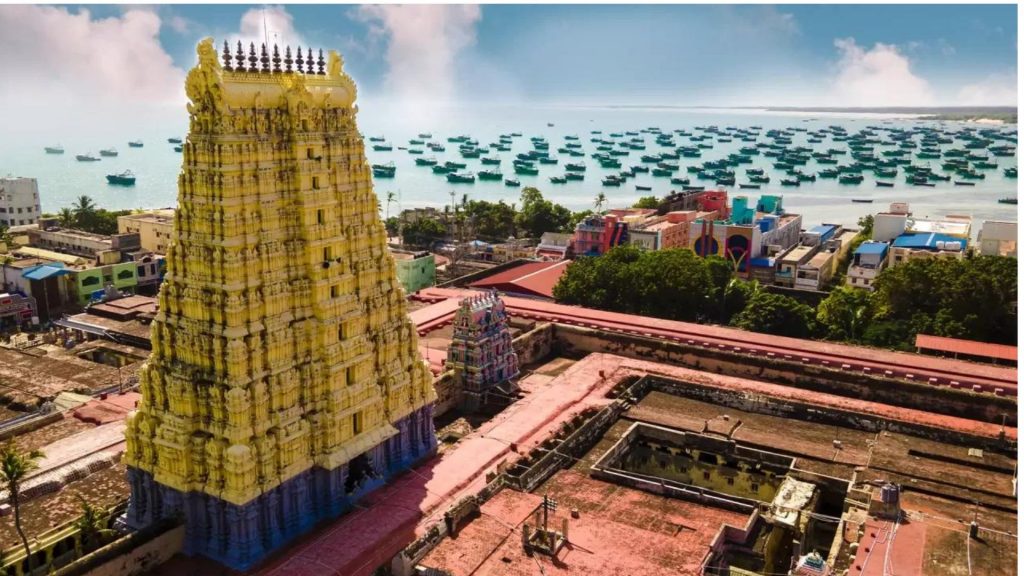Rameswaram is a town on Pamban Island, in the southeast Indian state of Tamil Nadu. It’s known for Ramanathaswamy Temple, a Hindu pilgrimage site with ornate corridors, huge sculpted pillars and sacred water tanks. Devotees bathe in the waters of Agni Theertham, off the beach east of the temple. Gandamadana Parvatham is a hill with island views.
Sri Ramanathaswamy Temple
Ramanathaswamy Temple is renowned for its architectural splendour and intricate craftsmanship. The temple complex spans over 15 acres and showcases a fusion of Dravidian and Vijayanagara architectural styles. The highlight of the temple is its impressive corridors, known as the “prakarams,” which are considered the longest in any Hindu temple in the world. The outer corridor stretches over 6 kilometres, with exquisitely carved pillars and ornate sculptures that depict mythological stories and characters from Hindu scriptures.
The temple features several sacred tanks or “teerthams,” and taking a holy bath in these tanks is an essential ritual for devotees visiting the temple. The most revered tank is the Agni Theertham, situated at the seashore, where pilgrims believe that Lord Rama washed away his sins. The temple also houses the Gandhamadhana Parvatham, a small hillock from where Lord Hanuman is believed to have leapt towards Lanka.
Due to the delay in Hanuman’s return, Lady Sita prepared the revered shrine of Shiva from the shore sand. Later, when Hanuman Ji arrived with Shiva Lingam from the Himalayas, it was installed in the vicinity of the shrine as well. Therefore, there are 2 lingams in the sacred temple; one built by Lady Sita entitled the Ramalingam and other brought from the Great Kailash by Lord Hanuman, called the Vishwalingam.
The blessed Rameshwaram Temple is also believed to be one of the 4 divine sites to attain Moksha. The Hindus believe in visiting the 4 Dhams namely, Badrinath, Puri, Dwarka and Rameshwaram for the attainment of eternal bliss. The pilgrim site is vastly popular as it is said that Lord Shiva will reside here till the doomsday. The legend says that Lord Rama requested the Supreme to never leave the sacred place so that the mankind can benefit from his untainted presence. People from all faiths flock here in huge numbers during the period of Maha Shivratri to pay their respects and offerings to Lord Shiva and take his blessings.
The colossal temple is spread over an enormous area of 15 acres consisting of mammoth Nandi idol, gigantic walls, lofty towers, massive gates, carved corridors and much more. The temple boasts of the world’s largest corridor in the world measuring 4000 feet in length and 4000 colored engraved pillars. The intricate work and detailing is noteworthy. Rameshwaram is known for its delicate hand art and the temple is the superlative example of it.
The numerous tales of the temple and the installation of the lingams have led to the gargantuan popularity of the Rameshwaram Temple. The tales may be many but they all coincide with the fact, that the idols were installed by Lord Vishnu’s incarnation. It has been a tradition of worshipping the Vishwalingam first and then the Ramalingam; and it continues till date. People take holy dips in the 22 sacred kunds of the temple for offering penance and washing theirs sins before reaching the 2 lingams. Believe it or not, but you can feel the lord’s presence in the air of the holy island. One has to see it to believe it that the purity and tranquility you feel here is heavenly and no other place or temple comes close to be god-like than Rameshwaram.
Rameswaram has an irreplaceable place in the hearts of Shaivites and Devout Hindus from around the world. The temple houses one of the 12 auspicious Jyotirlingas of Lord Shiva which are believed to be swayambhoo (self-manifested). Moreover, Rameswaram is also among the 275 Paadal Petra Sthalams in India. These are places where revered Shaivaite saints like Appar, Sundarar, and Tiruguna sang glorious hymns of Shiva. Historical evidence claims that Swami Vivekananda also visited the Rameswaram temple before his tour to Chicago.
The Rameswaram temple is also one of the destinations of the Char Dham Yatra, which is a pilgrimage of the highest ranks in Hinduism. It is believed that no pilgrimage bears full fruit without visiting this sacred abode of Mahadev. The Rameswaram temple has 22 teerthams (sacred ponds) having holy water which can rinse off all earthly evils from the body.
Rameswaram is known for cleansing all human sins and blessing the human body with eternal grace. Many devotees also come here to perform after-death rituals of their loved ones in an attempt of providing them salvation. Doing “Abhishek” (Coronation) of the Rameswaram Vishwalingam is the highest form of religious sanctity.
Many devotees who have visited Rameswaram claim that they felt an overpowering sense of relief washing over them during their entire visits. Some unique incidents that stand out are the ones related to the 22 holy teerthams of Rameswaram temple.
Some devotees claim that whenever someone bathes in the holy waters of the first few teerthams, he is reminded of all his sins committed in his entire life. People asserted that they could see all their wrong-doings and blips in their characters running like a slideshow inside their minds. They say that once someone has bathed in the first few teerthams, these visions start fading off and his mind becomes still. The other teerthams then work to add elements of peace and happiness in the person’s body. Although these are very intangible experiences, the large number of people who reported such visions is quite surprising.

Annai Indira Gandhi Road Bridge
The Annai Indira Gandhi Road Bridge, also known as the Pamban bridge, connects the National Highway (NH 49) with Rameswaram on Pamban Island. This impressive road bridge, inaugurated by former Indian Prime Minister Rajiv Gandhi in 1988, spans approximately 2.34 kilometers and runs parallel to the iconic Pamban rail bridge.
Situated amidst the serene sea, the Annai Indira Gandhi Road Bridge offers a stunning sight as it allows smooth passage for ships beneath it. Its proximity to the rail bridge adds to its charm, and it holds mythological significance as the spot where Lord Rama is believed to have quenched Goddess Sita’s thirst by striking an arrow into the ground.
Located in a high-velocity cyclone-prone zone, the area surrounding the bridge is characterized by tranquil blue waters, providing a captivating backdrop. Tourists often stop at the bridge to admire the picturesque view of the expansive cerulean waters stretching to the horizon, with the Pamban rail bridge gracefully spanning across the sea and small anchored boats drifting by.
Visitors can explore nearby attractions, including the scenic Pamban beach, which features a recreational park and tranquil surroundings ideal for a peaceful getaway.
The bridge, also known as the Pamban Bridge, is 2.345km long. The road over the bridge is asphalted. It is the longest bridge in southern India. It took close to 14 years to be completed. The bridge is located in the world’s second most corrosive environment after Florida, making its maintenance a challenging job. The location is also a cyclone-prone high wind velocity zone. The construction of this bridge has left many engineers wondering as it stands tall and strong even today. The ships too can pass under the bridge and hence it is most convenient means of commutation.


























